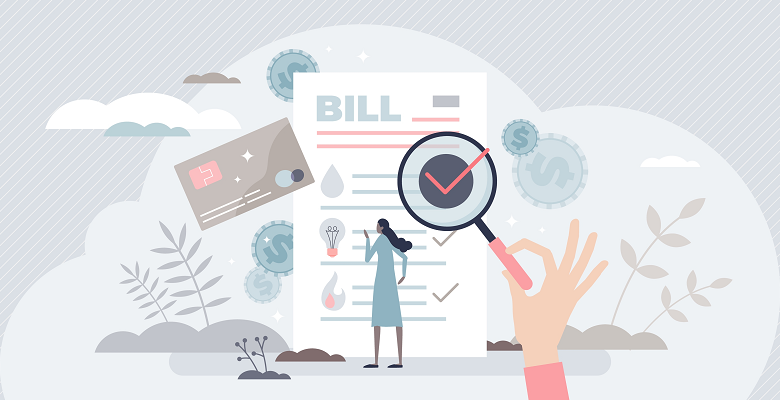How Much Do Apartment Utilities Cost by State?

This article was updated in June 2021.
The cost of rent is a set and transparent expense, but apartment utilities — such as electricity, natural gas, water, cable and internet — are not always straightforward. And, although some may be included in rent, the cost of utilities can really add up, so it’s important to know how much you should budget.
Fortunately, by doing a bit of research ahead of time, you can get a pretty good idea of how much you’ll have to pay, depending on your state. For instance, if you live in the northern states, you’ll save on utilities by not using air conditioning during the summer months, but you’ll also spend more on gas bills in the winter.
Check out the interactive map below to see what the typical apartment utilities are and how much you’re likely to pay each month, on average, in your state.
What Is the Average Electric Bill?
The electricity bill will likely be one of your highest monthly utility expenses. On average, the typical American uses 41% of their home’s total energy on space heating and cooling, and 35% on appliances, electronics and lighting. Your apartment electricity bill will also be higher or lower depending on the number of people in your household; the state you live in; the number of appliances and electronics using electricity; and the size of your apartment.
Notably, some states record higher average electricity consumption, which then leads to a higher average electricity bill. At the upper end of the spectrum is Hawaii with an average electric bill of $160. It’s followed by Alabama with $148 and Connecticut with $146. At the opposite end, the Colorado average is $82, whereas New Mexico’s is $80 and Utah sees an average electric bill of $73.
The number of rooms in your apartment will have a significant influence on your utility bills, as well. For example, the average electric bill for one-bedroom apartments is roughly $94 per month if you live alone, but it could go up by $75 (in total) or more if you live with roommates in a three-bedroom apartment. To that end, if your roommates leave on their computers for 10 hours a day every day or love blasting the A/C, your total electric bill could be $60 more. Therefore, if you have roommates, consider using apps to help you split the bills — an easy way to save money.
Tips for Saving Money on Your Electricity Bill

If you’re looking to save money on your electricity bill, it’s important to reduce your consumption. Specifically, one of the highest energy consumers in your home is the air conditioner, so it’s essential to learn how to optimize its performance. First, change the HVAC filters regularly and adjust the temperature. If you live in cooler places, you might not even need to use the air at all. Otherwise, if you live in the South or other warm areas, make it a habit to leave the thermostat at a higher temperature than what you would typically set it at during the winter months. Just a few degrees will make a big difference at the end of the month.
Another way to reduce your consumption is to swap out regular light bulbs with LEDs. Although they’re pricier upfront, LED bulbs last longer and consume less electricity. Similarly, consider incorporating smart power strips for appliances that enter standby when not in use, yet still consume electricity. These devices account for a significant portion of your energy consumption, which you can easily reduce. Alternatively, you could also unplug them when not in use.
What Is the Average Gas Bill?

When it comes to gas costs, southern states see some of the lowest prices, followed by the West Coast — due to both low monthly consumption and moderate prices. The lowest averages are found in Florida with a $38 average gas bill; Arizona with $46; and Louisiana with $47. In Idaho, Nevada, California and New Mexico, the average gas bill is less than $60. And, while most people use gas for heating their homes and cooking, average amounts may differ because the provider or local administrator could include additional fixed charges or taxes on the bill.
For instance, the average gas bill for a one-bedroom apartment will be around $46 per month during the cold season if your gas-fueled appliances are highly efficient. But, remember that weather is also an important variable and low temperatures during winter will significantly increase the heating bill. Consequently, the average gas bill for a three-bedroom apartment with a high-efficiency furnace and/or water heater can reach slightly more than $61. But, if you have low- to average-efficiency appliances, expect to pay more than $70 for a three-bedroom rental.
Tips for Saving Money on Your Gas Bill
To save money on your gas bill, first check the seals on windows and doors to determine if you’re losing heat anywhere. Mostly used during the winter to warm the home, gas consumption can also be reduced by adjusting the temperature — and a smart thermostat can help with this. Likewise, get used to lowering the temperature during the winter, even if only by a few degrees. The difference will certainly show up on your bill.
What Is the Average Internet Bill?

Nowadays, an internet connection is a must-have for most households. And, with the rise in popularity of remote work, it’s more essential than ever. However, average internet prices can vary from as little as $20 in Washington, D.C. to as much as $70 in Alaska. Of course, depending on the provider and plan you choose, rates may be even higher.
Similarly, if you want cable TV, you can contract it separately or bundle it with your internet or other services. However, streaming services may be a less expensive way to go. Or, if you have a high-speed internet connection, you could even skip cable television and just stick to the online options, instead.
Tips for Saving Money on Your Internet Bill
A little hunting for a special offer can go a long way if you want to save money on your internet bill. First, check what your options are from various local providers so that you’re aware of the normal prices on the market. Then, look for any special offers, sign-up bonuses or discounts. You can also contact customer service and ask for a personalized deal. Usually, they’re willing to offer a discount if you’re willing to commit to their service.
What Is the Average Water Bill?

The average person uses roughly 85 gallons of water per day, which is split between the bathtub, toilet, washer and shower, as well as the water used for dishwashing, hygiene, drinking water and outdoor use. And, while utilities like water, sewage or garbage are often included in the rent, several other services related to water and sewer provision may also be part of a local bill — such as the clean water program, the drinking water program, stormwater policies and more.
So, before signing the lease, ask your landlord whether the water bill is included in rent. If it’s paid separately, then you’re looking at an average water bill of about $39 monthly — and, again, depending on where you live, this price can change. If you add an average sewer bill, you’re looking at an extra $55 monthly. On top of this, a small fee may also be added to your bill for garbage collection, but your rent or city fees most likely already include this amount.
Tips for Saving on Your Water Bill
Water consumption can be easily reduced. First and foremost, check for leaks in your bathroom or kitchen and fix them. Leaky faucets aren’t just noisy and annoying. They’re also a waste of water. To address this, replace your showerhead with one that is efficient and, while you’re at it, try to take shorter showers, as well.
Meanwhile, the washer and dishwasher will often have an efficient or eco cycle, which can reduce the amount of water being used. In this way, lower-maintenance clothes and lightly used dishes can be washed at colder temperatures and shorter cycles.
What Is the Average Cost of Apartment Utilities?

So, to see how utilities add up, consider a hypothetical tenant named Tom. Tom lives in Kansas and cranks up the air conditioning during the hot months, but runs high-efficiency heating appliances during the winter. Tom lives with three roommates, never cooks and likes to take extremely long showers. He has broadband and does not subscribe to any cable TV provider. If you’re like Tom and his roommates, you can expect to pay around $411 per month in total utilities for the apartment.
However, in addition to considering the average cost of apartment utilities, we also recommend checking with the landlord or the previous tenants to get a better idea of how much utilities cost for a specific apartment.
Check out the table below to find the average utility bills in your state:
Average Cost of Utilities in Every U.S. State
| State | Electricity | Gas | Water | Sewer | Cable | Internet | TOTAL |
|---|---|---|---|---|---|---|---|
| Alabama | 149 | 63 | 30 | 73 | 45 | 50 | 410 |
| Alaska | 118 | 135 | 68 | 72 | 55 | 70 | 518 |
| Arizona | 119 | 46 | 64 | 43 | 50 | 30 | 352 |
| Arkansas | 105 | 76 | 26 | 37 | 47 | 30 | 320 |
| California | 114 | 55 | 77 | 59 | 45 | 50 | 401 |
| Colorado | 83 | 64 | 39 | 59 | 47 | 30 | 321 |
| Connecticut | 147 | 137 | 69 | 73 | 45 | 50 | 521 |
| Delaware | 112 | 99 | 46 | 79 | 47 | 30 | 414 |
| District of Columbia | 92 | 88 | 26 | 66 | 23 | 20 | 316 |
| Florida | 129 | 39 | 33 | 65 | 47 | 30 | 344 |
| Georgia | 123 | 87 | 28 | 87 | 47 | 30 | 401 |
| Hawaii | 160 | 62 | 64 | 60 | 45 | 50 | 442 |
| Idaho | 95 | 49 | 38 | 95 | 42 | 45 | 364 |
| Illinois | 87 | 103 | 26 | 26 | 47 | 30 | 319 |
| Indiana | 118 | 90 | 30 | 63 | 45 | 50 | 395 |
| Iowa | 94 | 72 | 32 | 33 | 55 | 50 | 337 |
| Kansas | 106 | 87 | 27 | 29 | 50 | 30 | 329 |
| Kentucky | 116 | 91 | 49 | 46 | 45 | 50 | 397 |
| Louisiana | 118 | 47 | 21 | 99 | 50 | 30 | 365 |
| Maine | 93 | 138 | 24 | 67 | 45 | 50 | 416 |
| Maryland | 123 | 93 | 46 | 83 | 47 | 30 | 422 |
| Massachusetts | 128 | 116 | 34 | 46 | 47 | 30 | 401 |
| Michigan | 108 | 89 | 29 | 44 | 47 | 30 | 347 |
| Minnesota | 95 | 76 | 28 | 37 | 47 | 30 | 313 |
| Mississippi | 131 | 63 | 23 | 51 | 47 | 30 | 345 |
| Missouri | 99 | 93 | 39 | 72 | 45 | 50 | 398 |
| Montana | 92 | 63 | 38 | 47 | 45 | 50 | 336 |
| Nebraska | 94 | 70 | 23 | 23 | 50 | 30 | 290 |
| Nevada | 103 | 53 | 26 | 20 | 50 | 30 | 281 |
| New Hampshire | 113 | 109 | 27 | 43 | 47 | 30 | 370 |
| New Jersey | 107 | 82 | 72 | 29 | 47 | 30 | 367 |
| New Mexico | 80 | 57 | 32 | 21 | 47 | 30 | 267 |
| New York | 105 | 115 | 30 | 47 | 45 | 35 | 378 |
| North Carolina | 114 | 72 | 20 | 41 | 45 | 50 | 342 |
| North Dakota | 105 | 83 | 31 | 27 | 42 | 45 | 332 |
| Ohio | 103 | 112 | 27 | 32 | 45 | 50 | 369 |
| Oklahoma | 100 | 87 | 35 | 33 | 50 | 30 | 334 |
| Oregon | 100 | 67 | 76 | 122 | 47 | 30 | 442 |
| Pennsylvania | 110 | 102 | 31 | 27 | 47 | 30 | 346 |
| Rhode Island | 131 | 123 | 32 | 42 | 50 | 30 | 408 |
| South Carolina | 134 | 67 | 33 | 116 | 47 | 30 | 427 |
| South Dakota | 115 | 65 | 26 | 33 | 55 | 50 | 344 |
| Tennessee | 126 | 64 | 43 | 87 | 47 | 30 | 397 |
| Texas | 130 | 65 | 37 | 66 | 47 | 30 | 375 |
| Utah | 73 | 62 | 38 | 101 | 47 | 30 | 352 |
| Vermont | 101 | 125 | 18 | 25 | 47 | 30 | 346 |
| Virginia | 124 | 85 | 36 | 31 | 50 | 30 | 357 |
| Washington | 95 | 84 | 75 | 72 | 47 | 30 | 403 |
| West Virginia | 121 | 83 | 91 | 92 | 35 | 30 | 452 |
| Wisconsin | 95 | 70 | 18 | 19 | 45 | 50 | 297 |
| Wyoming | 90 | 80 | 53 | 60 | 45 | 50 | 379 |
Moving from One State to Another: The Difference in Utilities Costs
If you’re thinking of moving from one state to another, learning about the difference in apartment utilities cost can help you in designing your budget. We’ve created this calculator to help you get an idea of average utility prices in different states.
Methodology:
- Electricity bill: State average electricity prices for residential consumers (January 2021) multiplied by residential average monthly consumption for each state (in KWHs, 2019)
- Gas bill: State average natural gas prices for residential consumers (March 2021) multiplied by state average natural gas consumption for residential customers (in BTUs, 2019)
- Water and sewer bill: Local water and wastewater company rates (service charge plus consumption rate per 1,000 gallons) for major (among the three largest) cities in each state multiplied by consumption estimates (from the U.S. Geological Survey) for the average household size
- Internet and cable bill: Identified the least-expensive TV and internet plans available locally from top local and national providers. We used CableTV to identify company coverages for each state and company websites for the most affordable deals and bundles.
For additional clarity, the following assumptions were made:
Gas and electricity bills were calculated based on average consumption and rates, excluding fixed charges and taxes that might also be part of the bill, which are usually set by the provider company or local administration.
Similarly, water bills were calculated including the fixed charge and consumption. However, several local programs and taxes were excluded.
Finally, water rates differ between companies in the same state. As such, we used the prices for one of the water companies in the top three largest cities in that state for reference. We also used in our calculations the prices for ¾” standard meters where meter differences in price existed.
Compare Power’s calculator was also used for additional calculations as necessary.
Fair use and redistribution
We encourage you and freely grant you permission to reuse, host, or repost the research, graphics, and images presented in this article. When doing so, we ask that you credit our research by linking to RENTCafe.com or this page, so that your readers can learn more about this project, the research behind it and its methodology. For more in-depth, customized data, please contact us at [email protected].




